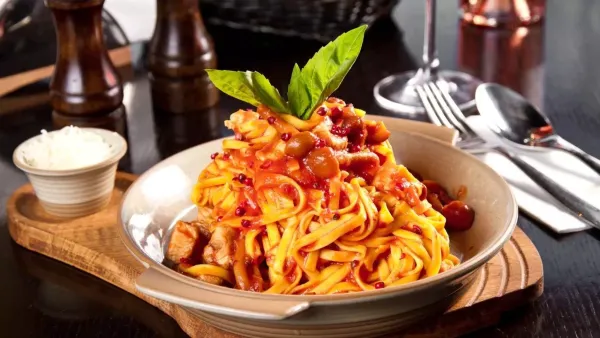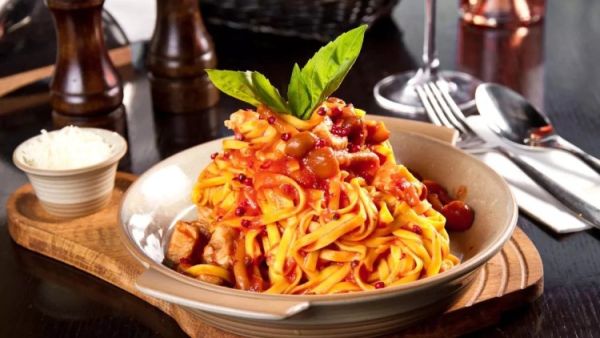
We commemorate World Pasta Day on October 25th to honor the significance of this comfort meal worldwide. However, have you ever pondered how it came to be? Pasta has become a popular dinner, and there are now many selections in every area. However, the Italians’ role to making it a worldwide cuisine cannot be overlooked. Pasta is inextricably linked to Italian cuisine, and the country’s love of pasta dates back centuries, even to the Middle Ages. However, how precisely did this romance start, and what is the true origin of pasta in Italy?

A Contentious Initiation
Pasta’s history is rife with controversy and intrigue. According to a well-known urban legend, Marco Polo brought pasta to Italy in the thirteenth century during his visits to China. This has long been refuted by historians, however, since pasta existed in Italy centuries before Polo’s time. There are certain possibilities, but the precise origin of pasta is still up for debate.
Pasta may have been invented by the Etruscans, a prehistoric culture in central Italy that existed before the Romans. They may have possessed pasta-making equipment, according to evidence found in an Etruscan tomb. This idea, however, is shaky. Pasta was brought to Sicily by Arab merchants in the eighth and ninth centuries, according to a more frequently recognized theory. They carried with them durum wheat-based dry noodles, which were appropriate for lengthy trips and the temperature of Sicily. Durum wheat, a vital component of pasta, is still produced in considerable quantities in Italy today.
One thing is definite, even if its origins are unknown: pasta was already being consumed in Italy throughout the Middle Ages. Pasta is mentioned in both literature and art. For example, Giovanni Boccaccio’s 14th-century work The Decameron, which satirically depicts pasta cooks cooking mountains of macaroni and ravioli, has references to pasta. Pasta then spread across the nation and developed into the cherished dish it is today, becoming an essential component of Italian cuisine.
Pasta broke down barriers of class as it became more and more popular. Despite being served differently based on income, it became a staple food for both the wealthy and the poor. While the affluent would add opulent items like pig belly, cow udders, and spices like cinnamon and raisins to their pasta meals, the poorer classes used pasta as an inexpensive and satisfying source of energy. Due to the influence of Arab merchants, several Sicilian pasta recipes still have these classic Middle Eastern flavors.
Pasta had become so important in Naples by the 17th century that the locals were known as “macaroni eaters.” Even though pasta was being combined with a variety of ingredients at the time, making it was still a labor-intensive procedure. As evidence of the work required, the name “macaroni” itself is derived from a Sicilian phrase that describes the rigorous kneading of pasta dough.
Pasta and Tomatoes Became Best Friends
The arrival of tomatoes in Europe marked a turning point in the history of pasta. Despite being introduced to Europe in the 16th century, tomatoes were first avoided in cooking because they were believed to be toxic. The tomato’s place in Italian cooking, especially in pasta, wasn’t established until the 19th century. In 1790, Francesco Leonardi’s cookbook included the earliest known usage of tomato sauce with pasta. Pasta and tomatoes’ marriage became an integral component of Italian culinary history after this.
The Italian Renaissance, which lasted from the 14th to the 17th century, was a period of gastronomic innovation in addition to artistic and intellectual development. Pasta recipes were more complex and sophisticated throughout this time. Italian chefs began experimenting with novel culinary methods, forms, and sauces. Pasta was transformed from a straightforward, rustic meal to a culinary art form with the introduction of tomato sauce and innovative pasta forms like farfalle (bow ties) and conchiglie (shells). Regional pasta varieties also started to appear around the same period. For instance, Bologna and Emilia-Romagna created pastas like tortellini that are packed with cheese and meat, while Naples gained notoriety for its spaghetti.
Italian immigrants extended their love of pasta across continents by bringing their culinary traditions with them as they traveled the globe. Italian pasta was modified to suit regional flavors and ingredients in various nations, resulting in the development of new recipes that integrated pasta into a variety of culinary traditions. Pasta became a worldwide sensation as a result of this interchange, which also enhanced Italian cuisine.
In addition to being a representation of Italian ancestry, pasta comes in more than 300 various forms today. They take great satisfaction in their pasta-making methods, which include employing ridged molds to maximize sauce absorption and drying pasta for extended periods of time. They produce both fresh pasta (pasta fresca) and dried pasta (pasta secca). There has also been a lot of creativity in pasta-making, with contemporary chefs pushing the envelope by trying out novel flavors, textures, and ingredients. One aspect of pasta’s strong ties to Italy’s culinary heritage has not changed in spite of these developments.